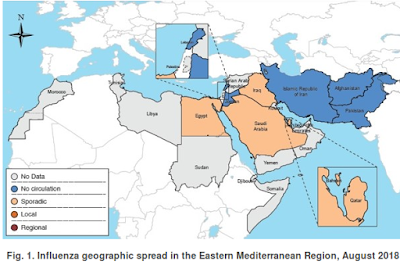#13,496
The arrival and temporary quarantine of 3 planes (1 in NYC, 2 in Philadelphia) last week carrying passengers and/or crew exhibiting flu-like symptoms prompted a number of media stories, some of which mentioned a `flu outbreak' in Mecca related to the Hajj.
Respiratory infections among religious pilgrims leaving the Hajj are quite common (see EID Journal: Respiratory Viruses & Bacteria Among Pilgrims During The 2013 Hajj), but I've not found any official reports of a`flu outbreak' in Mecca this summer.Since today's surveillance report only covers through the end of August, and the Hajj ended on Aug 24th, it may be that its cut-off date prevents it from capturing any post-Hajj flu uptick.
But as you'll see, according to this WHO EMRO report, for most of August, influenza was trending down across the Middle East.
Influenza monthly update, August 2018
In the WHO Eastern Mediterranean Region, influenza activity continue to decrease in the month of August in many countries reporting data to FluNet and EMFLU namely, Afghanistan, Bahrain, Egypt, Iran (Islamic Republic of), Iraq, Jordan, Lebanon, Pakistan, Qatar and Saudi Arabia (Fig. 1).
Influenza activity by subtype
- In August 2018, no new cases of human influenza A(H5N1) were reported in Egypt.
- In the northern Africa influenza transmission zone, Egypt reported sporadic circulation of A(H3) virus.
- In the Western Asia influenza transmission zone, Qatar and Saudi Arabia reported co-circulation of all seasonal influenza viruses. In Iraq, influenza B virus was detected, while Bahrain reported sporadic detection of A(H3). Jordan and Lebanon reported no activity.
- In southern Asia transmission zone, Afghanistan, Iran (Islamic Republic of) and Pakistan reported no activity.
Circulating influenza viruses by subtype
- During August 2018, national influenza centres and influenza laboratories in the Region tested a total of 2239 specimens for influenza viruses of which 197 tested positive (9%).
- The average percentage of positivity rates is 9%, with highest positivity rate recorded in Bahrain, Iraq and Qatar.
- Of the viruses tested; 128 (65%) were influenza A viruses, including 95 (48%) influenza A(H1N1)pdm09 virus and 24 (12%) were influenza A(H3) virus. Influenza B (lineage not determined) virus accounted for 69 (35%) (Fig. 3).
Admittedly, these WHO surveillance reports are only as good as each individual country's surveillance and reporting system, and that can vary widely around the world.
Presumably, if there is anything more than the expected post-hajj spike in routine ILI's, we'll hear about it from other channels in the days to come.


